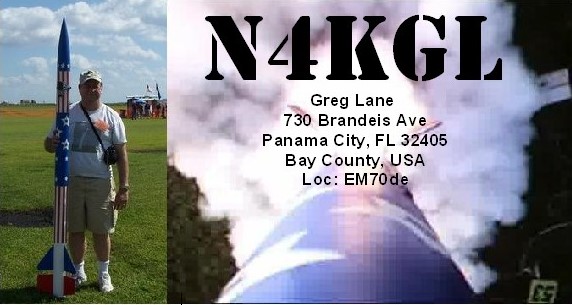Thanks to all who were listening for the N4KGL/B beacon on 14.060 MHz which was launched at 1730 UTC on Saturday Feb 12th from the
SouthEast Alabama Rocketry Society (SEARS) Launch Site in Samson, AL. Here is my report:
The boost on the H123 motor went well and apogee is estimated to be 1500 feet. There was no excessive tilt due to the trailing antenna wire. The ejection charge went off near apogee and the four foot diameter chute deployed. At that point something began free falling. As the items left under the chute were being pushed by the wind I had to keep my weak eyes on that part. The chute part landed three minutes after pushing the button to launch. So I thought there was a three minute hang time for the beacon but that was not the case because the recovered part under the chute was the booster and not the beacon payload. After getting back to the flight line the beacon was still transmitting on the ground. At that point I found my rotatable dipole could null out on the signal and give a line on the beacons direction. I took the SST-20 and started walking around with just a little wire as an antenna. So it was helping the location effort but someone found the beacon payload before I did. The payload was intact and undamaged. There was no damage to the trailing wire. The forces at apogee ejection caused the payload to separate. The payload was connected with a cardboard tube that had two screws instead of a glue joint and the cardboard screws tore from the screws.
Here are the reports
WA2OQJ Jim Long Island NY: warbly signal 559 gone at 1731 I also monitored the Beacon freq. at launch time and within seconds of the quoted launch time 1730 utc I was treated to the sound of N4KGL/B coming out of my FT-817's speaker! 559 sig rpt here in Long Island NY. I give it a 9 tone wise only because the chirpy/warbly sound I could not be sure was from the transmitter itself or the because of the speed of the rocket's ascent.
WJ5O Bill Troy AL: I heard two beacon message ID's abt 41 seconds after the launch....Very clear and easy copy... Ground mounted vertical antenna.
N0WX Mike Northfield MN: Heard the beacon clearly at 17:31z rst 567 some chirp on signal. Strong enough that a qso would have been easy. Had to use narrow filter to block other stations 72 Mike
VE3GTC Graham Embrun, ON: I could occasionally "hear" a signal that would be on the right
frequency and at the right time but could only make out the occasional G
or K or L. The signal report for the Rocket Beacon would be RST 228 or
in SINPO 13442.
AB9CA/4 Dave Loxly, AL: I made a recording from about 1725 to 1735 in case you want to hear what it sounded like from here. I was likely in the skip zone although at one point I hear something in there that could be you. It is just a brief letter that is immediately wiped out by the QRM.
K4KQZ John Columbia TN: No Copy Lots of QRM
I am estimating the beacon was in the air for one minute. It takes 10 seconds to get to apogee based on simulations and then the payload would have taken 50 seconds to fall. That would be 30 feet per second in free fall. The payload had the CG in the center and would have a good bit of drag since the payload would be mostly horizontal. The one minute duration fits with the report from WA2OQJ Jim.
I was very pleased with the reports from NY and MN and in particular W5JO in Troy AL because he would be direct wave instead of skip. So what I have learned is the design of the rocket is appropriate for the task. I will have to rework at the construction so the payload stays with the rocket. The hang time next try would be less maybe two minutes instead of three minutes. The chirp may have been because I am running a 12 V transmitter on 9 volts. The battery was the same one I had done testing with. So a fresh one might do better.
Thanks to all who were listening and thanks to John K4JGH, Cliff K4CTO, Dick K3IJD, and Dr. Roy Houchin and his friend Projestus who assisted in the launch and the recovery.
73s,
N4KGL
Greg
Panama City, FL




